Do you love rice, but hate the hassle of making it? Do you always end up with sticky, gooey rice no matter how careful you are? If so, then a rice cooker is definitely for you! Not only does a rice cooker make perfect rice every time, but it’s also really easy to use. In this blog post, we will teach you all about rice cooker measurements so that you can make perfect rice every time.
One thing to keep in mind is that different types of rice require different amounts of water. For example, basmati rice requires less water than jasmine rice. So, if you’re using a basmati rice, you’ll want to use less water than the measurements we give below.
How to measure the ingredients for perfect rice every time
If you’ve never used a rice cooker before, the prospect of cooking perfect rice may seem daunting. But there’s no need to worry – with a little practice, you’ll be an expert in no time. Here are answers to some common questions about using a rice cooker, as well as some troubleshooting tips if your pot of rice doesn’t turn out quite right.
What kind of rice should I use?
Long grain rice is best for most recipes, but you can also use short grain or sushi rice. Avoid using brown rice, as it takes longer to cook and may not come out as fluffy.
How much water should I add?
The general rule is to add 1 cup of water for every 1 cup of uncooked rice. However, this may vary depending on the type of rice you’re using and your personal preferences. If you like your rice on the drier side, you can reduce the amount of water slightly.
What if my rice is too dry?
If your rice is coming out too dry, try adding a little bit more water next time. You can also try covering the pot with a lid after the Rice Cooker has turned off, which will help to absorb any remaining water.
What if my rice is too wet?
If your rice is coming out too wet, try reducing the amount of water slightly. You can also try cooking the rice for a shorter time.
The importance of rinsing your rice before cooking
One of the most important steps in cooking rice is to rinse it before cooking. This simple step helps to remove debris and impurities from the rice, resulting in a final product that is cleaner and tastier. Rinsing also helps to prevent the rice from sticking together and becoming clumpy. Furthermore, it allows the rice to absorb water more evenly, resulting in perfectly cooked grains. So next time you’re making rice, don’t forget to give it a good rinse first! Your taste buds will thank you.
Tips for making perfect rice every time
Cooking rice seems like it should be simple, but it’s easy to end up with a pot of mushy or undercooked grains. To achieve perfect rice every time, start by selecting the right type of rice for your dish. Then, follow these tips:
- Rinse the rice several times before cooking to remove any dust or debris.
- Use the correct ratio of water to rice. For white rice, this is usually 1:2.
- Bring the water to a boil before adding the rice.
- Once the water has returned to a boil, reduce the heat and simmer for the recommended cooking time. Depending on the type of rice, this can be anywhere from 10 to 45 minutes.
- Do not lift the lid during cooking, as this can allow steam to escape and result in dry or overcooked rice.
- After cooking, fluff the rice with a fork before serving.
following these tips, you can enjoy perfectly cooked rice that is fluffy and delicious every time.
Troubleshooting common problems with rice cookers
Though rice cookers are designed to make cooking rice a hassle-free process, sometimes things can go wrong. If your rice cooker is giving you trouble, here are a few troubleshooting tips. First, check to make sure that the rice is properly cooked. If the rice is still hard or crunchy, it may need more cooking time. However, if the rice is overcooked and mushy, it may be because too much water was used. Second, check the lid to make sure it is secure and not damaged. If the lid does not fit properly, steam can escape and cause the rice to cook unevenly. Finally, check the power cord and plug to make sure they are securely connected. If the cord is frayed or the plug is loose, this could be causing an electrical hazard. With these troubleshooting tips in mind, you should be able to get your rice cooker back on track in no time.
Conclusion:
We hope that this rice cooker measurements guide has armed you with all the knowledge you need to make perfect rice every time. Just remember, practice makes perfect! Have fun experimenting in your kitchen and finding your own favorite ratios of water to rice.


